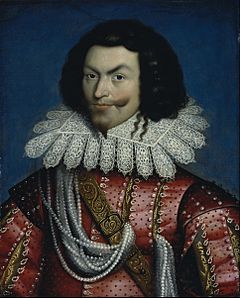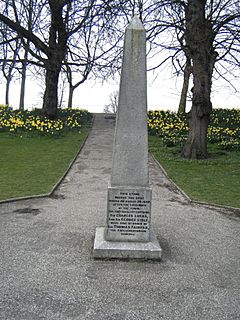George Lisle (Royalist) facts for kids
Quick facts for kids
Sir
George Lisle
|
|
|---|---|

Sir George Lisle, late 1630s; 1713 engraving based on now lost portrait
|
|
| Master of the Household | |
| In office 1645–1648 |
|
| Military Governor of Faringdon | |
| In office December 1645 – June 1646 |
|
| Personal details | |
| Born | 10 July 1615 London |
| Died | 28 August 1648 (aged 33) Colchester |
| Cause of death | Executed by firing squad |
| Resting place | St Giles Church Colchester |
| Relations | Francis Lisle (1617-1644) |
| Parents | Lawrence (ca 1585-after 1660); Dorothy (before 1600-1650?) |
| Military service | |
| Allegiance | Royalist |
| Rank | Colonel |
| Battles/wars | Eighty Years War Siege of Breda (1637) Thirty Years War Battle of Vlotho Wars of the Three Kingdoms Edgehill; Chalgrove; First Newbury; Cheriton; Cropredy Bridge; Lostwithiel; Second Newbury; Storming of Leicester; Naseby; Siege of Faringdon; Colchester |
Sir George Lisle (born 10 July 1615 – died 28 August 1648) was a professional soldier from London. He fought in the later parts of the Eighty Years War and Thirty Years War in Europe. Later, he joined the Royalist side during the Wars of the Three Kingdoms in England. He was captured at Colchester in August 1648. A Parliamentarian court decided he should die, and he was executed by a firing squad with his friend Charles Lucas.
George Lisle was the son of a successful publisher. His family had connections to the powerful Villiers family. He started his military career in Europe before returning to England. He quickly became known as a brave and skilled leader. He was promoted to lead a large group of soldiers in the Royalist army. This army was defeated at the Battle of Naseby in June 1645. He gave up fighting at Oxford in June 1646 and made an agreement with Parliament.
When the Second English Civil War started in 1648, he joined the Royalist uprising in Kent. He then went to Colchester. After the town surrendered in August, he and Lucas were executed. They later became known as Royalist heroes.
Contents
Early Life and Family Connections
George Lisle was born in London and was baptised on 10 July 1615. He was the second of four children born to Lawrence Lisle and his second wife, Dorothy. His father, Lawrence, was a successful publisher.

In 1616, Lawrence published a book about George Villiers, 1st Duke of Buckingham. Buckingham was a very important person at the court of King James VI and I and later King Charles I. This connection helped the Lisle family become friends with the powerful Villiers family. Lawrence Lisle received many good opportunities because of this friendship. He even claimed to have lost a lot of money supporting the Royalist cause. These connections greatly helped George's chances for a good career.
George had an older half-sister, Elizabeth, and two younger siblings who lived to be adults: Francis (who died in battle in 1644) and Mary. George Lisle never married and did not have any children.
Military Career and First Civil War
Even though most professional officers came from wealthy landowning families, George Lisle's connections helped him join the army. He served with the Dutch States Army in 1637 when they took back the city of Breda. He likely joined a group of English soldiers who were helping the King's nephew in Europe.
By 1639, he was a captain in the army during the Bishops' Wars. These wars were the start of the Wars of the Three Kingdoms. When the Irish Rebellion of 1641 began, George and his brother Francis were supposed to join the army fighting in Ireland. However, the First English Civil War started in England in August before they could leave.
Lisle spent the next three years with the Royalist army based in Oxford. He started as a Lieutenant-Colonel of dragoons (soldiers who rode horses but fought on foot). He fought in the Battle of Edgehill in October 1642. He became known for his bravery and reliability. People said he sometimes refused to wear armor to show his men he was not afraid.
In 1643, he fought at Chalgrove and was wounded at the First Battle of Newbury. Soon after, he was promoted to colonel. He led an infantry regiment (a large group of foot soldiers) at Battle of Cheriton in March 1644. During the campaign in the west, he commanded a brigade at battles like Cropredy Bridge, Lostwithiel, and the Second Battle of Newbury.
On May 29, 1645, Lisle helped capture the city of Leicester. Sadly, during this capture, many civilians and prisoners lost their lives. At the Battle of Naseby on June 14, the main Royalist army was destroyed. Most of Lisle's soldiers were also lost. He was seriously wounded early in the battle and taken to Leicester. He recovered and returned to Oxford in October.
With the Royalists losing the war, King Charles I gave out special jobs to keep his officers loyal. Lisle was knighted (given the title "Sir"), made Master of the Household, and became governor of Faringdon. These jobs were mostly honorary by then. In June 1646, Oxford and Faringdon surrendered, ending the First Civil War.
Second Civil War and Execution
In March 1646, Parliament offered pardons to Royalists who agreed to pay a fine and promise not to fight again. This was called "compounding." Lisle went to London in January 1647. He stayed there while Parliament tried to deal with money problems and unpaid soldiers.
When the Second English Civil War began in April 1648, Lisle joined Royalists in Kent. This uprising was led by the Earl of Norwich and Charles Lucas. After their forces were defeated, the remaining soldiers went to Colchester. Lucas took command there. He refused to surrender because he knew he might be executed for breaking his promise not to fight Parliament again. After an eleven-week siege, the town was starving and surrendered on August 28.

The end of the first war and the second war were very harsh. There was a lot of anger, especially against those like Lucas who had broken their promise not to fight. Lisle was also linked to Prince Rupert, who was blamed for some harsh actions. Lisle's presence at the capture of Leicester also caused problems for him.
Other captured leaders, like Lords Norwich and Capell, were sent to London for trial. Lucas, Lisle, and Sir Bernard Gascoigne were sentenced to be executed right away. Lucas died first, then Lisle. It is said that Lisle bravely told the firing squad to come closer so they would not miss. Gascoigne was spared, and most of the other soldiers were sent away from England.
Historians believe these executions happened because people were frustrated about having to fight another war. They were also angry that the siege of Colchester lasted so long for no good reason. Lisle and Lucas were not close friends, but their deaths linked them forever as Royalist heroes. After the King returned to power in 1661, they were reburied in St Giles Church in Colchester. Their memorial can still be seen there today.
Later, in the Victorian era, people remembered Lisle and Lucas again. A monument was put up in their memory at Colchester Castle.
Sources

